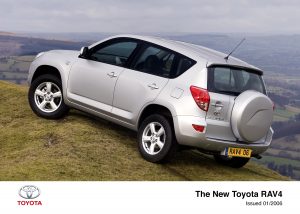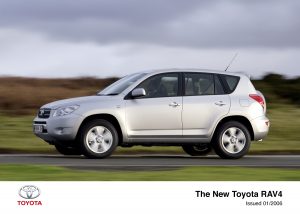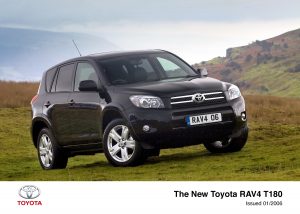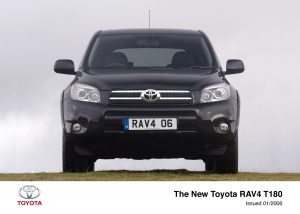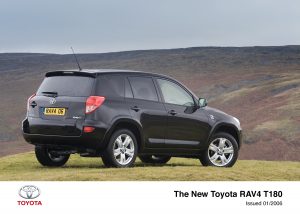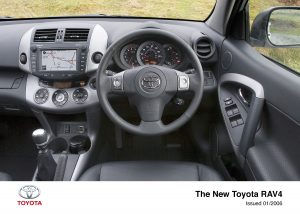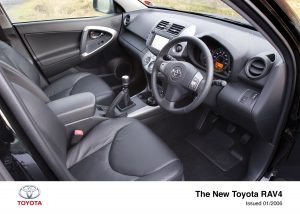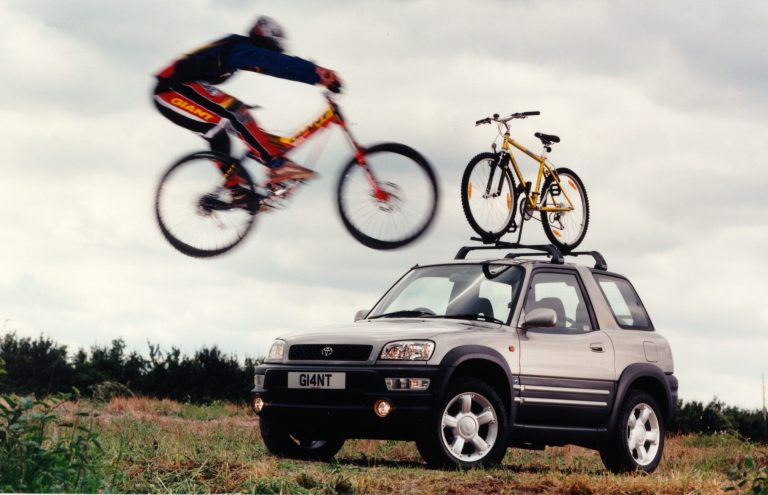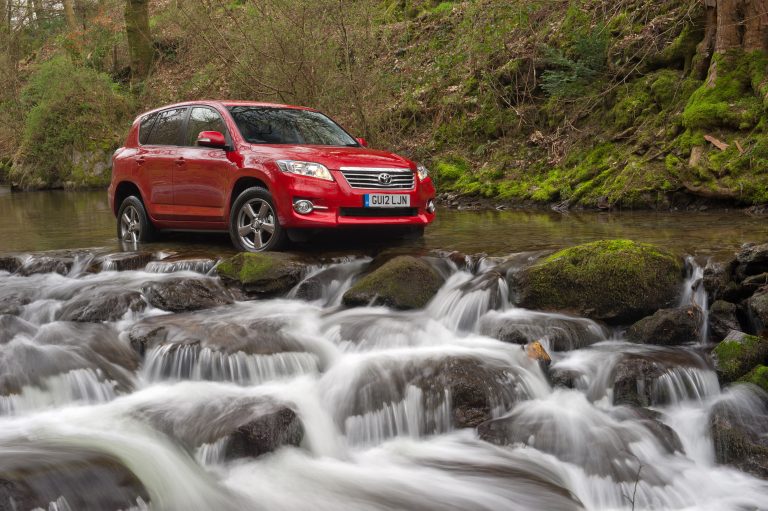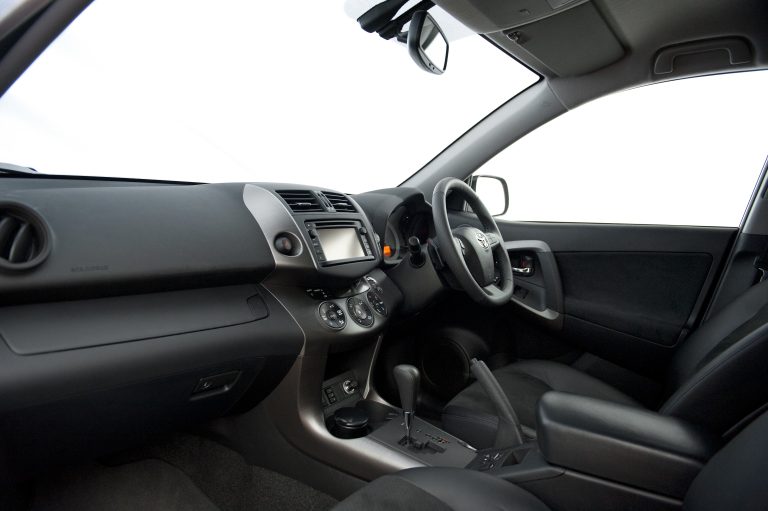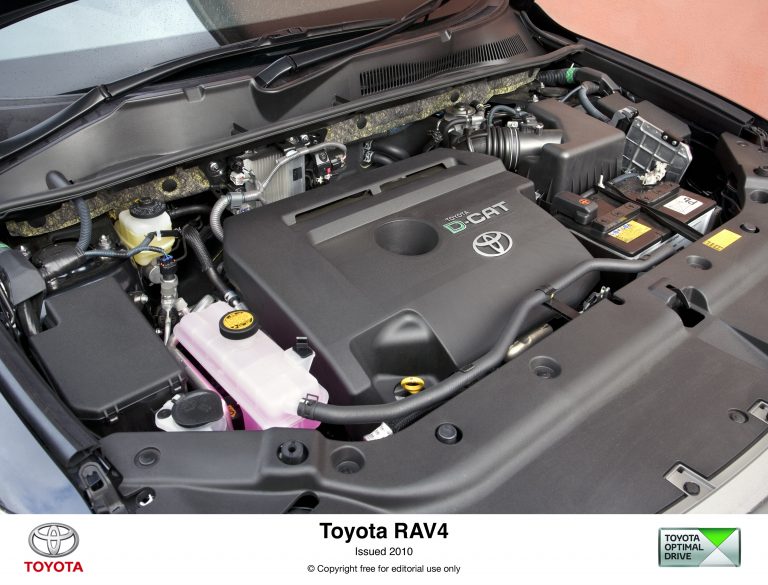The New RAV4: Excellence All Round
The Toyota RAV4 was the inspiration for a new market segment for compact SUVs when it was launched in 1994 and has since proved an enduring success, with in excess of 1.8 million sales worldwide. More than 655,000 of these have been in Europe, where RAV4 has consistently been the best-selling 4×4 passenger vehicle.
The all-new, third generation model sets new benchmarks in its segment with premium levels of driving performance, quality, comfort and equipment.
New diesel engines that are cleaner, more powerful and more fuel efficient; new suspension for improved ride and handling; more advanced safety systems for occupant and pedestrian protection; a new, more versatile interior design; and fresh exterior styling combine to reinforce the RAV4’s reputation for all-round excellence.
DESIGNS ON SUCCESS
- All-new RAV4, third generation of the world’s most successful compact SUV
- Rugged and modern five-door body
- Longer and wider than previous model, but easier to manoeuvre
- Significant increase in interior space, including 47 per cent more luggage room
- Toyota Easy Flat folding rear seat system
The RAV4 has been totally redesigned and is longer and wider than before, providing more cabin space for passengers and a 47 per cent larger load area.
The interior is more flexible, too, with the adoption of Toyota’s Easy Flat system, which allows the rear seats (split 60:40) to be folded flat into the vehicle floor. A single lever action is all that’s needed to do the job – headrests and the seat cushions can be left in place. Handy storage spaces have been created throughout the vehicle, including a generously-sized underfloor compartment in the boot.
NEW ERA ENGINES
- Three engines – revised 2.0-litre VVT-i petrol and new-to-the-range 2.2-litre D-4D 140 and 180 diesels
- 175bhp (177 DIN hp) 2.2-litre D-4D 180 engine exclusive to flagship T180 model
Two of Toyota’s new generation 2.2-litre D-4D common rail diesel engines are offered in the RAV4 for the first time.
The D-4D 180, with 175bhp (177 DIN hp) and nought to 62mph acceleration in 9.3 seconds, is the most powerful engine in its class, yet will return 40.4mpg in combined cycle driving. Notably fuel economy and emissions levels are better than for the previous generation RAV4’s 2.0-litre D-4D engine.
The D-4D 180 is available exclusively in the new RAV4 flagship model, the T180. The volume diesel power unit is the D-4D 140, delivering 134bhp (136 DIN hp), nought to 62mph in 10.5 seconds and 42.8mpg (combined).
Both engines have lightweight all-aluminium construction and benefit from engineering advances to achieve new low levels of noise and vibration. Low compression ratios and, in the D-4D 180, the use of piezoelectric fuel injectors, contribute to the excellent economy and low exhaust emissions. Toyota D-CAT (Diesel – Clean Advanced Technology) applied to the D-4D 180, including the unique DPNR four-way catalyst system, gives the engine world-leading combined nitrogen oxides (NOx) and particulate matter (PM) emissions.
The new RAV4 is also available with an improved 2.0-litre VVT-i petrol engine, revised to give 150bhp (152 DIN hp), nought to 62mph in 10.6 seconds (12 seconds automatic) and 32.8mpg in combined cycle driving (31.4 automatic).
Diesel models are equipped with Toyota’s latest six-speed manual gearbox, a compact and lightweight unit designed for smooth and precise gear shifts. Petrol models offer the choice of five-speed manual or four-speed automatic transmissions.
ADVANCES IN SAFETY
- Ultra-tough in-house crash testing
- Nine airbags, including first-in-class driver’s knee airbag, standard on all models
The new RAV4 has been designed from the outset to achieve the highest, five-star ranking for occupant protection in Euro NCAP testing. More than that, it has also been subjected to Toyota’s more stringent in-house simulations, which analyse crash performance at higher speeds.
The RAV4 has a new, impact-absorbing chassis, designed to minimise the degree of deformation in the event of an accident, by absorbing impact forces and channelling them away from the cabin.
The design also takes into account the risk to pedestrians, with energy absorbing elements and crumple zones around the front end of the vehicle, repositioning of the radiator and bonnet catch, and detail changes to the headlight brackets and wiper units.
Inside the vehicle, nine airbags are provided as standard, including a first-in-class driver’s knee airbag, and a dual warning system with light and buzzer ensures both driver and front passenger buckle-up. The front seats feature the latest Whiplash Injury Lessening (WIL) design for improved support in a rear impact.
HANDLING THE ROUGH AND THE SMOOTH
- Active Torque Control 4WD system automatically transfers torque between front and rear wheels for optimum performance in all conditions
- First-in-segment Integrated Active Drive System (XT4 grade and higher)
- Hill-start Assist Control (HAC) standard on XT4 grade and higher, plus Downhill Assist Control (DAC) on models with automatic transmission
One of the key elements in the ground-breaking appeal of the original RAV4 was its excellent on-road performance, with handling more like a sporting hatchback than a conventional 4×4. Through the years this quality has been continually refined and in the new generation RAV4 reaches a new level with the introduction of Active Torque Control four-wheel drive.
This system continuously monitors and controls the transfer of torque between the front and rear wheels to achieve the optimum grip and handling. The ratio can range from full front-wheel drive to a 55:45 front-to-rear balance. Instead of a centre differential, the system uses a network of electronic sensors monitoring performance data, including steering angle, vehicle speed, engine torque and throttle angle.
The RAV4 is also the first vehicle in its segment to offer Integrated Active Drive. This combines and coordinates the Active Torque Control 4WD, the Vehicle Stability Control Plus (VSC+) and Electric Power Steering (EPS) to help bring the vehicle under control if the onset of a skid or slide is detected. This provides much smoother and more effective intervention to help the driver keep control than in vehicles where the functions operate independently of each other.
Further aids newly available for safe progress include Hill-start Assist Control (HAC) and, on models with automatic transmission, Downhill Assist Control (DAC), which automatically applies braking pressure on steep descents without the wheels locking.
The RAV4 benefits from new suspension designs with MacPherson struts at the front and double wishbones at the rear. The new rear system features diagonally-mounted shock absorbers beneath the boot floor, causing less intrusion in the load space.
EQUIPPED TO PLEASE
- Four trim levels – XT3, XT4, XT5 and T180
- Alloy wheels, air conditioning, sound system with CD player and MP3/WMA compatibility, Easy Flat folding rear seat system and remote central double locking and alarm standard on all models
- Flagship T180 equipped with run-flat tyres and tyre pressure warning system
The RAV4 is available in four grades: XT3, XT4, XT5 and T180. All models feature driver and front passenger front and side airbags, curtain airbags and driver’s knee airbag, ABS with Electronic Brakeforce Distribution (EBD) and ISOFIX rear child seat mounts. XT4 grade models and higher additionally feature Integrated Active Drive System, Traction Control (TRC), Vehicle Stability Control Plus (VSC+), Hill-start Assist Control (HAC) and, on automatics, Downhill Assist Control (DAC).
The XT3 grade includes manual air conditioning, Toyota Easy Flat folding rear seats, slide and recline rear seat adjustment, Electric Power Steering, sound system with CD player and MP3/WMA compatibility, remote central double locking and alarm, Optitron instrumentation, colour keyed electric heated door mirrors, 17-inch alloy wheels with tailgate mounted hard cover for the spare, roof rails, body coloured bumpers, electric windows, driver’s seat height adjustment and tilt and telescopic adjustment for the steering wheel.
The XT4 specification includes an electric tilt/slide sunroof, dual zone climate control, front fog lamps, retractable mirrors, glove box cooler, leather upholstery and remote audio controls on the steering wheel.
XT5 versions come with full map satellite navigation, Bluetooth connectivity, keyless Smart Entry and Smart Start system, rain-sensing wipers, dusk-sensing headlamps, cruise control, heated front seats and electric multi-adjustment for the driver’s seat.
The T180 rides on 18-inch alloys with run-flat tyres, so dispenses with the rear-mounted spare wheel. It also features a chrome finish to the front grille, wheel arch extensions, darkened rear privacy glass and smoked glass headlamps.
PRICES AND INSURANCE
- On sale in the UK from 6 February
- On-the-road prices from £18,995 (XT3 2.0 VVT-i)
In spite of its big advances in performance and specifications, new RAV4 is priced only slightly higher model for model than the previous generation vehicle. Insurance groups are unchanged from the previous RAV4 despite performance improvements. Full model range pricing and insurance groups are given in the table below.
|
MODEL |
OTR PRICE |
INSURANCE GROUP |
|
RAV4 XT3 2.0 VVT-i |
£18,995 |
11E |
|
RAV4 XT3 2.0 VVT-i auto |
£19,995 |
11E |
|
RAV4 XT3 D-4D 140 |
£20,295 |
11E |
|
RAV4 XT4 2.0 VVT-i |
£21,495 |
12E |
|
RAV4 XT4 2.0 VVT-i auto |
£22,495 |
12E |
|
RAV4 XT4 D-4D 140 |
£22,795 |
12E |
|
RAV4 XT5 2.0 VVT-i |
£24,495 |
12E |
|
RAV4 XT5 2.0 VVT-I auto |
£25,495 |
12E |
|
RAV4 XT5 D-4D 140 |
£25,795 |
12E |
|
RAV4 T180 |
£26,995 |
13E |
TOYOTA RAV4 TECHNICAL SPECIFICATIONS
|
ENGINE |
2.0-litre VVT-i |
D-4D 140 |
D-4D 180 |
||||||||
| Type |
Four cylinders in-line |
||||||||||
| Cylinder head material |
Aluminium |
||||||||||
| Engine block material |
Aluminium |
||||||||||
| Valve mechanism |
VVT-i 16-valve, DOHC, chain drive |
16-valve, DOHC, chain drive |
|||||||||
| Fuel system |
Electronic fuel injection |
Common rail with solenoid injectors |
Common rail with piezoelectric injectors |
||||||||
| Injection pressure (bar) |
n/a |
1,700 |
1,800 |
||||||||
| Bore x stroke (mm) |
86.0 x 86.0 |
86.0 x 96.0 |
86.0 x 96.0 |
||||||||
| Displacement (cc) |
1,998 |
2,231 |
2,231 |
||||||||
| Compression ratio |
9.8:1 |
16.8 :1 |
15.8 :1 |
||||||||
| Max. power [bhp (DIN hp) /rpm] |
150 (152) @ 6,000 |
134 (136) @ 3,600 |
175 (177) @ 3,600 |
||||||||
| Max. torque (Nm/rpm) |
194 @ 4,000 |
310 @ 2,000-2,800 |
400 @ 2,000 – 2,600 |
||||||||
|
PERFORMANCE |
2.0 VVT-i (5 M/T) |
2.0 VVT-i (4 A/T) |
D-4D 140 (6 M/T) |
D-4D 180 (6 M/T) |
|||||||
| Max. speed (mph) |
115 |
109 |
112 |
124 |
|||||||
| 0-62mph (sec) |
10.6 |
12.0 |
10.5 |
9.3 |
|||||||
| FUEL CONSUMPTION | |||||||||||
| Combined (mpg) |
32.8 |
31.4 |
42.8 |
40.4 |
|||||||
| Urban (mpg) |
25.7 |
24.4 |
34.9 |
33.6 |
|||||||
| Extra Urban (mpg) |
39.2 |
38.2 |
50.4 |
46.3 |
|||||||
| Fuel tank capacity (l/gal) |
60/13.2 |
||||||||||
| EMISSIONS & VED RATING |
2.0 VVT-i (5 M/T) |
2.0 VVT-i (4 A/T) |
D-4D 140 (6 M/T) |
D-4D 180 (6 M/T) |
|||||||
| CO2 (g/km, combined cycle) |
202 |
212 |
173 |
185 |
|||||||
| Carbon monoxide – CO (g/km) |
0.39 |
0.27 |
0.16 |
0.12 |
|||||||
| Hydrocarbons – HC (g/km) |
0.04 |
0.04 |
– |
– |
|||||||
| Nitrogen oxides – NOx (g/km) |
0.02 |
0.04 |
0.22 |
0.13 |
|||||||
| HC + NOx (g/km) |
– |
– |
0.23 |
0.14 |
|||||||
| Particulate matter- PM (g/km) |
– |
– |
0.016 |
0.003 |
|||||||
| VED Rating |
F |
F |
E |
E |
|||||||
|
SUSPENSION |
|||||||||||
| Front |
MacPherson strut |
||||||||||
| Rear |
Double wishbone |
||||||||||
|
BRAKES |
|||||||||||
| Front (mm) |
Ventilated discs (Ø296 x 28) |
||||||||||
| Rear (mm) |
Solid discs (Ø281 x 12) |
||||||||||
| Additional features | All versions |
ABS, Electronic Brakeforce Distribution, Brake Assist, Downhill Assist Control (A/T models only) |
|||||||||
| XT4 and above |
Traction Control ,Vehicle Stability Control, Hill-start Assist Control |
||||||||||
|
STEERING |
2.0 VVT-i & D-4D 140 |
D-4D 180 |
|||||||||
| Type |
Rack and pinion, Electric Power Steering |
||||||||||
| Ratio (:1) |
14.4 |
14.6 |
|||||||||
| Turns lock to lock |
2.8 |
2.7 |
|||||||||
| Min. turning radius – tyre (m) |
5.1 |
5.4 |
|||||||||
|
TYRES AND WHEELS |
2.0 VVT-i & D-4D 140 |
D-4D 180 |
|||||||||
| Wheel size |
17 x 7J alloy |
18 x 7.5J alloy |
|||||||||
| Tyre size |
225/65 R17 |
235/55 R18 run-flat |
|||||||||
| WEIGHTS |
2.0 VVT-i (5 M/T) |
2.0 VVT-i (4 A/T) |
D-4D 140 (6 M/T) |
D-4D 180 (6 M/T) |
| Kerb weight (kg) |
1,465 |
1,505 |
1,585 |
1,595 |
| Towing capacity (unbraked) kg |
750 |
750 |
750 |
750 |
| Towing capacity (braked) kg |
1,500 |
1,500 |
2,000 |
2,000 |
| Gross Vehicle Weight (kg) |
2,070 |
2,110 |
2,190 |
2,190 |
| TRANSMISSION | ||||
| Type |
Electronically-controlled 4WD |
|||
| Clutch type |
Dry, single plate |
|||
|
GEAR RATIOS |
2.0 VVT-i 5 M/T |
2.0 VVT-i 4 A/T |
D-4D 140 & D-4D 180 6 M/T |
|
| 1st |
3.833 |
3.938 |
3.818 |
|
| 2nd |
2.045 |
2.194 |
1.913 |
|
| 3rd |
1.333 |
1.411 |
1.218 |
|
| 4th |
1.028 |
1.019 |
0.880 |
|
| 5th |
0.820 |
– |
0.809 |
|
| 6th |
– |
– |
0.711 |
|
| Reverse |
3.583 |
3.141 |
4.139 |
|
| Final drive ratio (f/r) |
4.562/2.277 |
3.291/2.277 |
4.312 (1st-4th) 3.631 (5th-6th)/2.277 |
|
| DIMENSIONS – EXTERIOR | ||||
| Overall length (mm) |
4,395 (4,315 T180) |
|||
| Overall width (mm) |
1,815 (1,855 T180) |
|||
| Overall height (mm) |
1,685 (1,720 with roof rails) |
|||
| Wheelbase (mm) |
2,560 |
|||
| Tread width – front (mm) |
1,560 |
|||
| Tread width – rear (mm) |
1,560 |
|||
| Front overhang (mm) |
860 |
|||
| Rear overhang (mm) |
975 (895 T180) |
|||
| Coefficient of drag |
0.31 |
|||
| DIMENSIONS – INTERIOR | ||||
| Interior length (mm) |
1,820 |
|||
| Interior width (mm) |
1,495 |
|||
| Interior height |
1,240 (1,165 with sunroof) |
|||
| DIMENSIONS – BOOT | ||||
| Capacity – seats in place (l) |
586 |
|||
| Capacity – seats folded (l) |
1,469 |
|||
| Load area length (mm) |
800 (1,500 with seats folded) |
|||
| Load area width (mm) |
1,335 |
|||
| Load area height (mm) |
995 |
|||
ENDS


